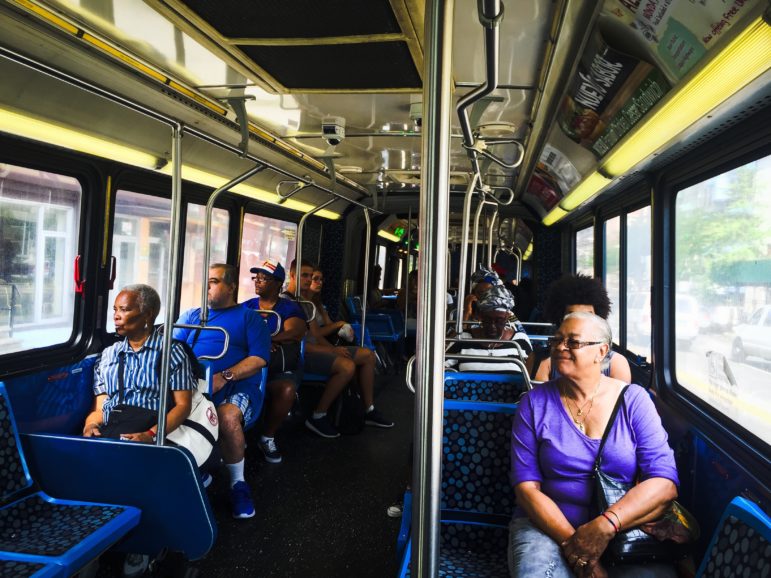
Milana Vinn
Passengers of the bus Bx19, leaving the Bronx and entering Manhattan on a Wednesday morning, Aug. 31st, 2016.
The subway system is one of the crowning achievements – and most frustrating burdens – of New York City.
In contrast, the bus system is the poor relative, often ignored or taken for granted, the last resort for people who need cheap, reliable transportation to the many areas of the city that are harder to reach, and probably always will be.
But the bus system is the lifeline, the “jugular,” one rider observed, for millions of people. In the Bronx, daily ridership is more than 500,000 passengers a day, out of a daily citywide ridership of 2.5 million on roughly 6,000 MTA buses.
City Limits and the NYCity News Service at the CUNY Graduate School of Journalism sent reporters out to ride some of the Bronx buses on a recent mid-summer weekday. Here’s what they saw and what they heard about how Bronx passengers rely on bus service – even as they grumble that it is sometimes unreliable. – William Mathis
First bus ride in America
“It’s not coming yet,” Carmen Villar, 52, says in Spanish as she peers east down Pelham Parkway for the Bx12 bus. “It’s his first day of work and we’re running late.”
Villar usually takes the subway, but on this afternoon she is accompanying her stepfather, Leonardo Barrera, 69, on his very first New York City bus ride.
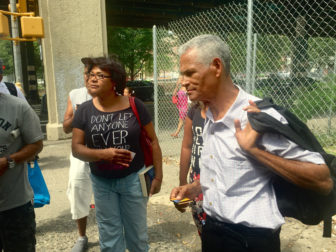
William Mathis
Leonardo Barrera, 69, gets on a Bx12 bus, his first time ever on New York City bus since he immigrated from the Dominican Republic two weeks earlier.
“He just got here from the Dominican Republic two weeks ago,” Villar says. “He doesn’t know how to move around yet.”
In a crisply ironed short-sleeve button-down shirt and spotless black jeans, Barrera has no complaints as he waits for the bus that will take him to his first job in the United States, at an antiques store in University Heights.
“I’m new here,” Barrera says in Spanish. “I’m just getting accustomed, I’m observing.”
Villar, who moved to the Bronx from the Dominican Republic 33 years ago, is less calm.
“It’s horrible that it takes so long to arrive,” she says. “I pay my taxes and I want better service.”
After about 15 minutes, the bus hisses to a halt in front of them. Villar guides her stepfather through the etiquette of public transportation.
“Take out your card, Papi,” she tells Barrera as they join a crowd of passengers who hover in front of the door. “And let the people off first.” – Mathis
The bus is often late, and some people don’t pay
Near the bus stop on the corner of Wadsworth and 181st Street, people stand on the sidewalk under the shade, some smoking, some talking. One man sits next to a cooler filled with bottled water. Gabriella Santiago is waiting for the Bx3 bus.
Santiago says most of the people riding the bus are Dominican. She prefers the subway, but likes the bus, too. “I work in Washington Heights and I live in Washington Heights, so it’s just easier.” However, she also notes, “The only problem is the bus is always late – like 15 minutes between buses. Other than that, it’s good.”
The bus pulls up, and five people get on. Santiago sits on the side, while others move to the back. On frequent stops as it heads north deeper into the Bronx, the Bx3 quickly fills up. Some sit silently next to strangers, while others talk to their friends or on their phones.
The bus bounces onto University Avenue, where the bus stops are more substantial approaching Bronx Community College.
Sarah Gordon, 74, a longtime Mount Hope resident, says it irks her that some passengers get on without paying. “And there’s no cop or anything to stop them,” she says. – Jeremy Ibarra
The only option
For some of the 2.5 million New Yorkers who use mass transit each day, the bus is the only local option. “The subway is far,” says Elsa Yuiqui, 53, a Bronx-based nanny who says the Bx36 bus stops right outside her apartment near East Tremont and is a straight shot to Manhattan.
Lesbia Grullón, 31, on her way to visit her cousin in the West Bronx via the Bx36 line, says she doesn’t often take public transportation, but when she does, she takes the bus. “I feel safer,” she says. She prefers to be in plain view of the street, where anyone could see if something were to happen to her.

Samia Bouzid
María Rodríguez, waiting for the Bx15 bus in the South Bronx, says that chemo treatments have prohibited her from taking the stairs into the subway. Instead she takes the bus, where she can board conveniently from the street.
María Rodríguez, waiting for the Bx15 on Third Avenue and East 156th Street, is a cancer patient who says stairs to and from subway platforms are out of the question. “The bus is more convenient,” she says, “now that I can’t walk very much.”
Alejandro Polanco, 17, who rides the Bx15 bus to Morris Academy in the South Bronx, says he finds the bus more friendly than the subway. “I’m an optimistic person and I like to talk to people,” he says. “If you notice, people on the subway, they’re always silent.”
Melvin James, 59, who is on disability and takes the bus almost daily to doctor appointments and social service programs, says the bus is calmer and friendlier. “The subway is more intense,” he says. – Samia Bouzid
The indispensable bus
Yes, subways can be faster and more convenient, and draw more daily passengers than buses. But there are reasons to take the bus sometimes or all the time. At the Concourse Village bus stop, passengers are explaining why they’re riding the bus on this particular day.
Suleima Nivar says she’s on the Bx2 bus only because she doesn’t have school on this day. “Usually I take a subway; it’s faster, especially if you’re traveling long distances,” she says.
Routes Bx1 and Bx2 are tied for sixth place on the list of the 10 busiest bus routes in New York, with combined ridership of about 12 million, according to MTA data.
Gaga Rabis, 29, a student nurse, says has to take the Bx19 bus to Hostos Community College, even though it can be slow. “There is no subway line from here to my school,” she says. “Sometimes I wait 30 minutes for a bus across the bridge, when it takes me 20 minutes by walk.”
Angel Cardenas, 37, takes both subways and buses regularly from his home in Harlem across the Bronx to his work as a veterinarian in White Plains. Buses need better and more regular cleaning, he says: “Sometimes there is a garbage on the floor. Windows are dirty.” – Milana Vinn
The passenger with the bus to himself
At midday, Frank Garcia, 58, rides the BxM6 Bus from Fifth Avenue and 34th Street to Parkchester in the Bronx, all alone except for the driver. Garcia, listening to Spanish music from his headphones, left work a little early — around 11 a.m. — after not feeling well. He’s a railroad supervisor at Penn Station, and came in that morning at four o’clock.
Garcia says he became hooked on the express bus route the first time he took it, 12 years ago. “I said I’m never going back. You get spoiled,” he says.
He sits erect in his upholstered seat — unlike the plastic blue seats on local buses — in a button-down shirt and tie. In the more than a decade he’s taken this particular express bus, only once was it crowded – after Hurricane Sandy.
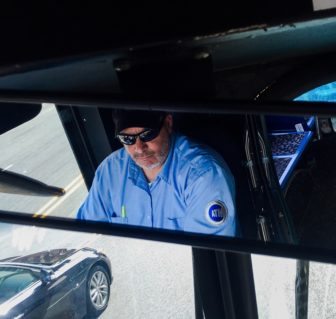
Milana Vinn
A bus driver, who says he has 12 years’ experience, traveling on the route Bx19 from the Concourse Village to Harlem.
“There was standing room only. It was not easy,” Garcia says. “But they didn’t charge any fare.”
The subway and local bus rides cost $2.75, but the MTA Express buses cost $6.50 per ride.
“I’ve been riding the subway for 50 years. I’ve seen it all,” Garcia says. “My space is not interrupted here. It’s safer.”
Ordinarily, when he’s not coming home early, Garcia says he sees the same people every day on the bus.
“But we don’t have long conversations,” he says. – Annie Nova
On the bus, small can be good
Casandra Hernandez hops aboard the Bronx Bx10 bus en route to her job as a nanny. The 19-year-old native New Yorker commutes to both work and school every day by way of the bus. Bright-eyed and petite, Hernandez is quick to secure a spot standing on the bus.
“This is one of the benefits of being a small person,” she tells her friend, Rachel Margolin, 23. “You can fit in places you’re not technically supposed to be.”
Hernandez nods toward the yellow line on the bus’s floor next to the rear exit. The yellow mark warns passengers to remain inside of the line. On many days, but not this one, passengers are crowded over the line.
Hernandez, a Lehman College student, says the bus line, which operates in the northwestern part of the borough between Norwood and Riverdale, is often overcrowded.
“There are times when it’s so crowded you are touching other peoples’ shoulders and can’t move,” she says. “Sometimes it’s so full the bus driver won’t even stop at the bus stop to pick you up.”
Margolin, also a nanny and student, agrees.
“I’ve waited for the bus for 45 minutes before,” she says. “The 10 is a popular bus line.”
The Bx10 not only takes passengers across the borough, but is also a major link to the subway’s No. 1, 4 and D lines, connecting commuters to Manhattan.
The overcrowding issue is a longtime problem, other passengers agree.
“I’ve been here my whole life and it’s nothing new,” says Jack Dickson, 54, who commutes from his home in Harlem to his job in the Bronx as a health care specialist. “The buses are still too crowded.”
“The streets are all discombobulated up here,” Dickson says. “It’s almost mandatory to ride the bus.”
In 2015, weekday bus ridership in the Bronx spiked to more than 2 million people each day, according to the Metropolitan Transportation Authority (MTA) website.
Casandra Hernandez, trying to get to school, says bus problems can have a big impact on her life.
“You can’t tell your professor that you’ll be late because of the bus,” she says. “They’ll just tell you to get up earlier. But there is only so little sleep I can get. I need to take care of myself. Sometimes in New York it’s easier to walk than take a bus.” – Kellie Ell
The jugular of the Bronx
Kay Cardona, 58, a home health aide, uses the Bx12 bus to travel all over the city.
“You can get to pretty much anywhere you need to be,” she says as she settles into a seat on the Bx12 bus heading toward Orchard Beach on Pelham Parkway in the Bronx.
With the Bx12, Cardona says, she can travel across the borough from City Island in the East to University Heights in the West and even into the Inwood neighborhood in Manhattan. Throughout that circuit a rider on the bus can access the 2, 4, 5, 6, B and D subway trains to get almost anywhere in the city.
According to the MTA, more than 15 million riders took the Bx12 local and SBS in 2015, more than any other line in all five boroughs of the city.
Cardona, who is a lifelong Bronx resident and neighborhood activist, isn’t surprised at that statistic. Despite its reach, Cardona says there are a lot of issues with the busiest line in the borough.
“It could be improved,” she says. “The buses could run more quickly and more efficiently.” She says too often cars drive in the bus lane and construction shuts down lanes, which slows down her travel time.
Despite the drawbacks, Cardona says the Bronx relies on the Bx12 to survive.
“It’s the jugular of the Bronx bus system,” she says. “We would be dead without this bus.” Mathis
The Bx7 comes and comes, but no Bx10
At the 231st Street bus stop in Marble Hill, an elevated train rumbles above Broadway as people scramble to catch the Bx10 bus to Riverdale. After a few moments the hydraulics engage, lifting the bus as it pulls away.
Rey Hillery strolls up to the stop calmly, despite knowing she just missed her bus. She leans against the glass covering of the bus stop, settling in to wait for the next one. She relies on the bus system.
“I take the express bus into Midtown for school and the local buses to get around here. I usually take the Bx1 to school – it runs along the east side and it takes like 45 minutes,” Hillery says.

Milana VInn
Ricky Rodrigues, 21, a psychology student at CUNY City College, says he takes a bus Bx19 three times a week from his grandmother’s place on the Grand Concourse Street to school.
Hillery, a student at Hunter College in Manhattan, says could take the No. 1 subway line, but prefers the bus.
“The 1 train really isn’t that reliable,” Hillery says. “There’s a lot of construction and it feels like it’s never coming. Plus, the bus is more direct. It takes me right there.”
A Bx10 peeks from behind the archway supporting the overhead track. Hillery boards the bus on her way to visit family in Riverdale.
A man exiting the Columbia Florist shop across the street with a bouquet of sunflowers rushes to catch the next bus.
Gloria E., who preferred to not give her full last name, is catching a bus on her way to do some shopping. She uses the train when traveling into Manhattan, but typically sticks with buses for local travel.
“If I want to splurge I’ll take the express bus into the city – it has those nice cushioned seats and it’s nice and cool. But if I’m in a pinch I’ll take the train,” says Gloria. She says the weather sometimes influences her decision.
“If it’s cold and there’s snow I think it’s better to take the train, because you get out of it quicker. You don’t want to be standing around for a long time in that weather,” Gloria says.
Two Bx7 buses came into the stop at the same time, depositing a crowd of people onto the sidewalk. Bridget McNamara slowly makes her way around the throng of people and sits down at the stop, straightening her matching teal blouse and cotton pants. She’s on her way to visit a friend at an elderly housing facility.
“This stop is very busy because people transfer here from the train to get to Riverdale,” says McNamara says in a thick Irish accent. She runs her fingers through her short white hair with one hand fixing the wispy ends. She says she use to take the subway into the city – Manhattan, that is – when she worked, but now it’s much easier to take the bus.
“There’s so many stairs up to the platforms, it’s tough making it up there sometimes, right?” McNamara says.
She is waiting for a Bx10 bus, which shares this stop with the Bx7, but no Bx10 is in sight. Instead, another Bx7 bus, the third in short succession, pulls up to the stop. McNamara leans out to peer down the street.
“You see the Bx7 all over the place in Kingsbridge where I live,” a woman next to McNamara says.
“Yes, we’ve had three Bx7s just pass by but no Bx10,” McNamara replies, waving a hand.
“Oh that’s unusual. I need the other to get up the hill,” the woman says.
“Maybe it got stuck in a traffic jam up the street,” McNarama says. She says the buses get much busier during the holidays and when school starts back up.
“That’s the biggest problem is the school kids – there’s not much room on the bus when they get out of classes you know,” McNamara says. The other woman nods A few minutes later, a Bx10 bus arrives and kneels at their stop. They board the bus together. -Katherine Lavacca
A beach bus
At 10:50 a.m., the local Bronx BX12 bus stops at the intersection of Fordham Road and Jerome Avenue. A handful of passengers sit scattered on the bright blue seats. The air conditioning blows down, the engine roars and the passengers quietly keep themselves occupied, gazing either at their phones or out the windows.
According to the Metropolitan Transportation Authority website, the Bx12 buses in the Bronx were the busiest New York City buses in 2015, with nearly 16 million riders that year.
Jay Gonzalez, 36, sits in the middle of the bus listening to music from his phone. He uses the bus to get around town for his job as a case worker. His main complaint is that this particular bus is sometimes really noisy.
“In the mornings there are loads of people going to the beach, a lot of students, teenagers and kids,” he says. Then it’s noisy in the afternoons when kids are coming home from school. Listening to music, he says, is preferable to the sounds of the passengers and the traffic.
The bus is clean but not spotless, with tissue papers and plastic food wrappers tucked under seats. The bus terminates at Orchard Beach, where Xavier Chapman, 21, gets off to head to his job with the Parks and Recreation Department. The bus can get trashed, he says, but he doesn’t blame the MTA.
“People leave garbage all over the place, so it’s not the buses fault when it’s dirty,” he says.
From Orchard Beach, another BX12 departs back toward Sedgwick Avenue. A man carrying a large bag and a beach towel has to run to catch the scheduled 11:45 a.m. bus as it drives away three minutes early.
Behind him, more beachgoers gather to await the next bus.
Three stops later, the bus is crowded. Gia Davis, 34, takes this bus three days a week for her job as a home healthcare worker, but more often to get around town. “It’s crowded and annoying, mainly in the morning when I’m going to work,” Davis says. “There are enough buses in this area, but it’s just a lot of people on them.” -Puneet Sandhu
The ‘phantom buses’ of the Grand Concourse
Every afternoon, Lourdes R., 41, who didn’t want her last name used, waits for a bus on the Grand Concourse. And waits. And waits.
When she gets tired of waiting, she sometimes walks briskly to the next bus stop, and waits there for a while. Sometimes she ends up making makes her way on foot through most of Fordham Heights, pausing at Bx1/2 bus stops, looking for a bus, then moving on until she eventually catches one.
“The bus never comes. Sometimes I walk for 20 minutes,” she says as she takes a flyer from a club promoter at the corner of Grand Concourse and East 182nd Street. “People try to go to work or school, and they’re late.”
The Bx1 makes local stops through Riverdale and Mott Haven by way of Grand Concourse, and the Bx2 extends to Kingsbridge Heights. The routes are among the busiest in New York City’s, transporting nearly 12 million annually.
On a recent late-summer day, no bus has come at one stop for 25 minutes, and Lourdes is frustrated. Then two buses come, one right after the other.
“See, you wait forever and then all of the buses for the day show up at once,” says Wanda L., 53, who was crossing East 182 Street to the Mott Haven bound Bx1 stop.
“I’m just glad I don’t take this bus everyday,” says Yesenia C., 40, tapping a fluorescent pink cane up against a trashcan. “I don’t know if the drivers are taking long breaks, or if they don’t have enough buses, but the city needs to fix this.”
“You wait, and wait, and wait. But I can’t wait no more,” Wanda says, while flagging down a Boro Taxi. – Tiye Sheppard
Problems with New York City’s most popular bus
Arthur Avenue residents who want to get to a subway in a timely manner rely on MTA buses for transportation. Often that’s the Bx12 bus.
A young Bronx resident who gave her name only as Tyler uses the Bx12 bus to commute to and from work and to visit her boyfriend, who attends Fordham University. “It helps me get to work in Manhattan, since I commute from Riverdale,” she says.
“There’s no real problems with the bus, other than the fact that sometimes it doesn’t always run on schedule,” she says.
Steve, a Bx12 regular who lives near Arthur Avenue and also asked that his last name be used, says he doesn’t have much to complain about, either: “I ride it a couple times a week. It’s very convenient.”
Some Bronx bus passengers do have complaints, however. Harrison, a store manager for Elite Fashion on the corner of East 187th Street and Hoffman Street, says he’s happy to spend less time on buses.
“I moved right down the block, so I just walk to work now,” he says. “When I used to ride the buses, they were kind of dirty.” -Fran Kilinski
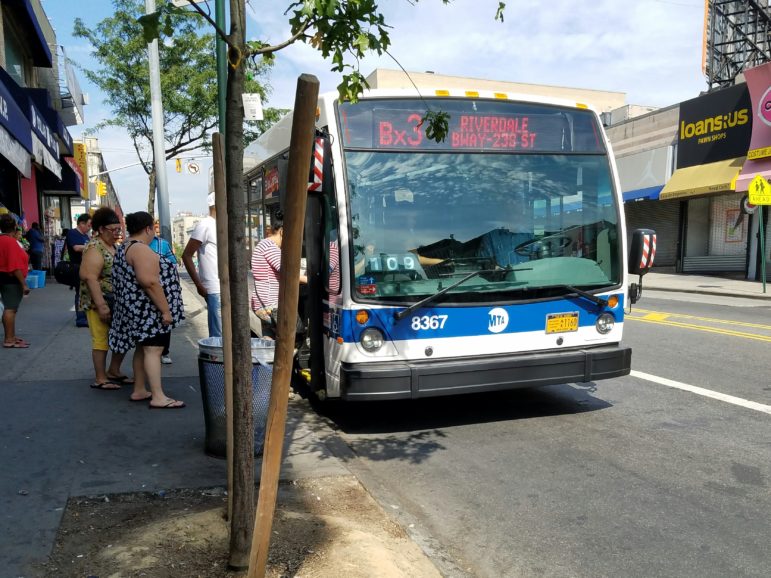
Jeremy Ibarra
The Bx3 pulls up to the designated stop, and the waiting passengers board the bus and take an open seat.




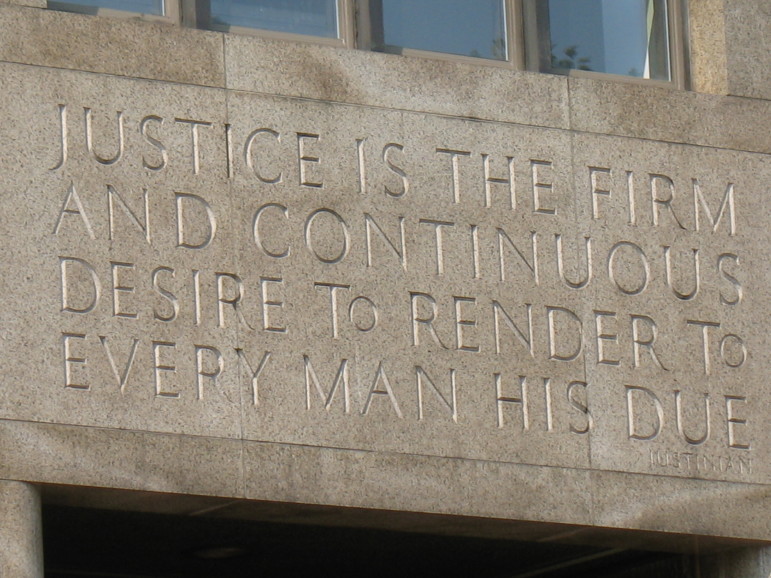

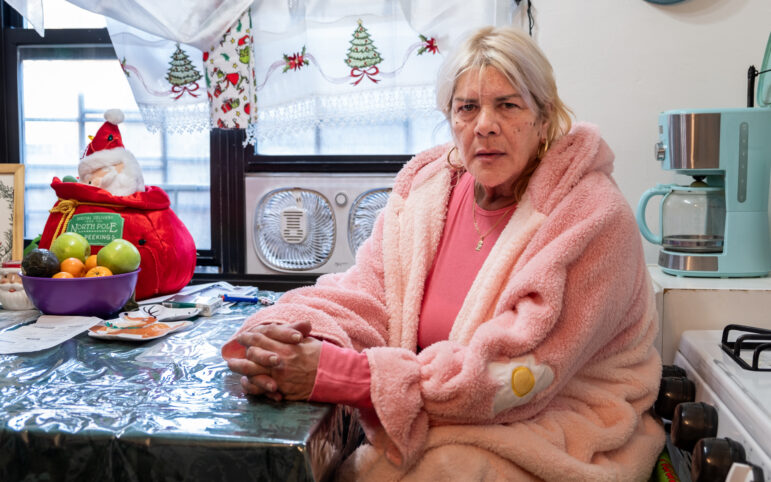


6 thoughts on “Slow, Late or Crowded, Buses are the Jugular of the Bronx”
Pingback: For Many, It’s Bus or Bust – New York City News Service
Buses have always been sort of an afterthought to the MTA. They rarely institute new routes.
The buses have always been less important to the MTA than the subway system.
The city must implement BRT features, where applicable.
This is excellent- thank you for covering an important and oft-overlooked aspect of environmental injustice in our city. It’ll be on the list of articles I assign to students in my “Shaping the Future of NYC” and “Community Based Research” courses this semester. One Q: Did you investigate who if anyone is organizing around this in the Bronx? If so what did you learn? Thanks!
Thanks Hillary! This story was very much a “snapshot” project, but I believe the Riders’ Council, Straphanger’s Campaign and others do steady work around the city to rally commuters around transit issues.